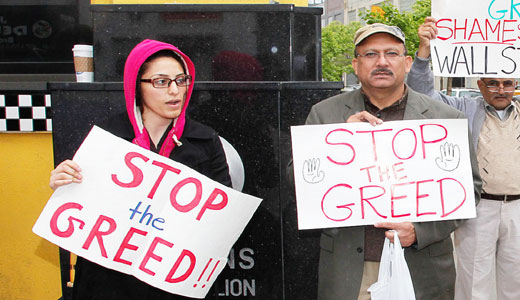
NEW YORK – At certain times in midtown Manhattan on a weekday afternoon, the avenues look like a stream of surging yellow, as taxi cabs roll and stop in an almost unbroken flow.
The 45,000 taxi cabs in New York City, taken as a whole, have been described as the seventh-largest transportation system in the United States.
And if you ask a driver, there’s a good chance he or she will tell you, “I’m a member of the National Taxi Workers Alliance (NTWA).”
Last year, the NTWA, based in New York and led by Bhairavi Desai, became the latest affiliate union of the AFL-CIO, and the first group to receive an organizing committee charter from America’s largest labor organization in a half-century. The members of NTWA have done groundbreaking work in unifying taxi workers, increasing drivers’ take-home pay and building a structure to provide the taxi workers access to health care.
The taxi workers are part of a new wave of workers who are organizing against the odds. Car wash workers, domestic workers and others who are not ordinarily thought of as union members are discovering and using the power of collective action to improve their lives and work. In early May, for instance, more than 235 mostly immigrant livery or “Black Car” drivers from Town Car International, located in Queens, voted by a 2-to-1 margin to be represented by the International Association of Machinists (IAM). The Communications Workers of America (CWA) and United Steelworkers (USW) and a few other unions represent cab drivers, but those drivers are employees, not independent contractors like the taxi workers in New York.
Being a cab driver in New York City is hard. Workers are often on the streets for 14 or 16 hours a day, six, sometimes seven days a week in what the U.S. Department of Labor labels one of the country’s most dangerous professions.
Taxi workers buy fuel themselves and pay high lease rates for vehicles-sometimes more than $60,000 over the usable life of a car worth $30,000. Most taxi workers also must lease medallions, which are the permits required for cabbies to pick up passengers who hail them on the streets of New York City. Garage companies charge drivers a 5 percent fee on every credit card transaction. And as independent contractors, the taxi workers are on their own to buy health insurance.
“All the risk is ours,” said NTWA member and taxi worker Jamil Hussain. “If gas prices rise, we earn less. If it’s a slow day, we earn less. But the company gets its money no matter what!”
For each problem, the NTWA has a solution. It has worked with New York City’s Taxi and Limousine Commission to run a trial program to cut the credit card fees by more than half. It has a health care plan for members in the works. The union has negotiated better car and medallion leases with some companies and has been pressuring others to do the same. Since December, the taxi workers have held more than 50 demonstrations against the companies that refuse to bargain.
In late April, AFL-CIO President Richard Trumka rallied with the taxi workers in the Long Island City neighborhood of Queens to publicly protest three of the worst companies.
“We’re united as never before!” called Desai into a bullhorn at the rally. “This is a historic moment as the AFL-CIO stands tall with taxi drivers. This is a new era, with dignity and respect!”
“New York City works because you work! We work together, and we’ll stand united! I’m here to tell you that you’re not alone,” shouted Trumka into the bullhorn to the gathered crowd of taxi workers and supporters. “Every single worker in the AFL-CIO stands with you, because you’re organizing for the same thing that all workers want-dignity, respect and a decent deal for the work you do!”
“With my union, I get a spiritual boost and the inspiration to overcome the obstacles on my track,” said taxi driver Hussain after the rally. “I’m a member of the AFL-CIO! It’s a great feeling! We are not the burden but the backbone of the American economy!”
This article was originally posted on the AFL-CIO Now Blog.
Photo: Union drivers protesting at Queens Medallion. (Stan Schnier)

MOST POPULAR TODAY


Zionist organizations leading campaign to stop ceasefire resolutions in D.C. area

Communist Karol Cariola elected president of Chile’s legislature

Afghanistan’s socialist years: The promising future killed off by U.S. imperialism

High Court essentially bans demonstrations, freedom of assembly in Deep South






Comments